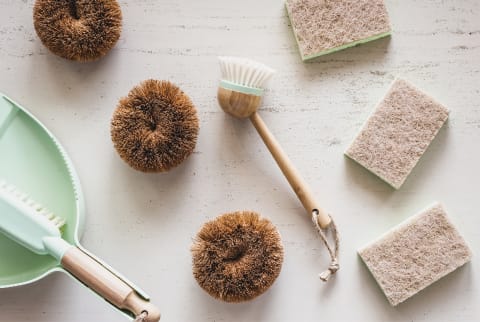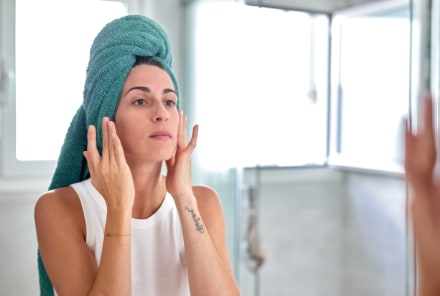Advertisement
A Test For Seeing Whether Your Home Has Mold — In Less Than 30 Seconds


Think you have to crack open your walls to see if there's mold in your home? Think again. There's actually a very simple way to check your home for mold—and it only takes about 25 seconds.
How to check for mold — by way of your toilet.
Go ahead and pop open the cover of your toilet tank and check the undersides. If there is mold present there, it could mean that you have mold somewhere in the house that's providing the spores needed to start growing inside your toilet tank.
When it comes to checking your toilet, you might be thinking, "But it's wet and dark. Seems like it's bound to have mold..." Not really! You're much less likely to find mold in the toilet tank than in other damp areas like the shower. The tank lid itself is heavy, but it's not hermetically sealed, which means that it doesn't allow for much air exchange.
Such little airflow means it's not impossible for a rogue mold spore to find its way inside, but the chances are fairly slim. However, colonized mold inside a home releases a high volume of spores into the indoor air—much more than would naturally be present. More spores mean the chances of mold growth in the tank go way up. That's why checking the toilet tank periodically can help alert you to a larger mold problem in your home. If it's inside, there were enough spores in the air to opportunistically find their way to your toilet to start growing.
The type of mold found in toilet tanks completely depends on which species are present in the home. Aspergillus or Penicillium are some of the most common, but with so many species identified thus far, any types could be present. Such a large number of species also means that the mold inside the toilet tank could be a variety of colors, from pink or tan to black and green, as well as a range of textures, such as velvety or powdery.
Why the toilet is such a good spot to look.
To get a sense of why this little trick works, you need to understand mold itself—which is actually two things. First, it's a tiny particle called a mold spore. When a mold spore is introduced to water, the earth's life source, it becomes part two: a living organism. This process is similar to how seeds become plants. Mold (the now-living organism) then reproduces by creating more spores that become airborne and search for water. Remember, just like seeds, these spores aren't living organisms until they find that water source.
This is an important fundamental to understand because as we talk about where to find mold in your home, we are looking to find the living organism. With over a hundred thousand species of mold identified so far, mold spores are pretty much everywhere. They're inside your home, floating around your car, and stuck to your dog's fur. It's an unavoidable fact of life and a part of the world's ecosystem. The spores themselves are not going to cause a problem inside your home unless your home has a source of water for it to opportunistically grow, though. That's why cleaning and air purification are important to reduce the number of accumulated spores in the home and to reduce wet growth opportunities.
If you have mold in your toilet tank, this could be a sign of a larger mold problem with a source or sources somewhere inside the home producing spores. At the very least, finding mold inside of my own toilet would prompt me to get an inspection and make sure that there isn't a larger problem elsewhere.
What to do if you find mold in your tank.
First things first: If you find mold inside of your toilet tank, take care of that mold problem first by using proper products and cleaning methods.
From there, look into hiring a mold inspector. Keep in mind, though, that not all mold inspectors are the same. You'll want to search for someone who prioritizes your health and spends a couple of hours thoroughly going through every room in your home, using a variety of measuring techniques and collecting a range of data from the types of mold present to mycotoxin and bacteria levels.
A comprehensive inspection can end up being thousands of dollars, unfortunately, but it's worth it to get an accurate picture of the state of a home. Think of it like going to the doctor and needing blood work and other tests to diagnose an illness. You'll probably spare no expense if it helps you feel better. I personally recommend Certified Mold Inspections, We Inspect, The Mold Guy, or Certified Mold Assessments depending on which state you live in.
However, if you just want to get an overview of what's in your home, I suggest starting with an ERMI test and having a professional like ERMIcode.com analyze the results for around $27.
The bottom line.
The next time you're in your bathroom, make sure to take a peek inside of your toilet tank! Catching mold growth early can help save money from a more extensive remediation project and ensure the air quality in your home is safe and healthy.
Watch Next
Enjoy some of our favorite clips from classes
Enjoy some of our favorite clips from classes
What Is Meditation?
Mindfulness/Spirituality | Light Watkins
Box Breathing
Mindfulness/Spirituality | Gwen Dittmar
What Breathwork Can Address
Mindfulness/Spirituality | Gwen Dittmar
The 8 Limbs of Yoga - What is Asana?
Yoga | Caley Alyssa
Two Standing Postures to Open Up Tight Hips
Yoga | Caley Alyssa
How Plants Can Optimize Athletic Performance
Nutrition | Rich Roll
What to Eat Before a Workout
Nutrition | Rich Roll
How Ayurveda Helps Us Navigate Modern Life
Nutrition | Sahara Rose
Messages About Love & Relationships
Love & Relationships | Esther Perel
Love Languages
Love & Relationships | Esther Perel

















